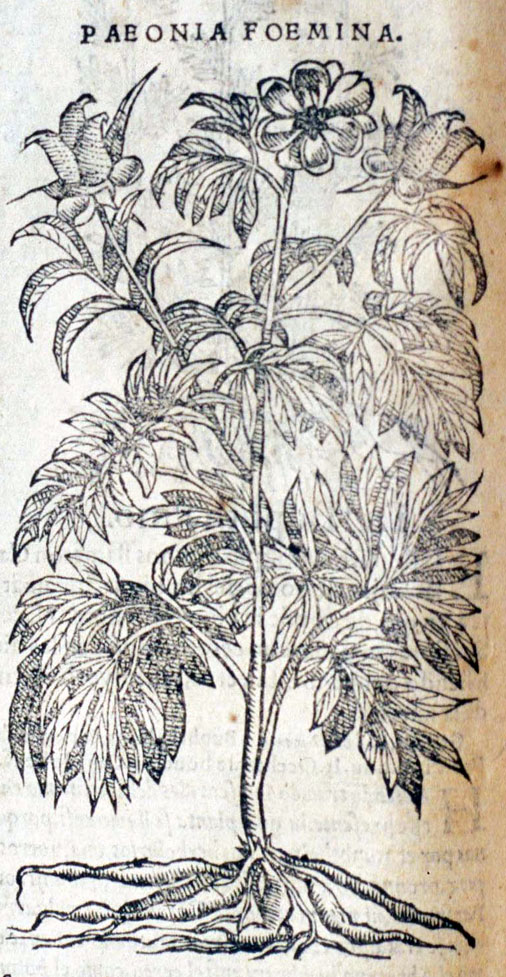Among the plants that, like Pantagruelion, have two sexes.
Notes
peony
Annotationes in Dioscoridem Anazarbeum … iuxta vetustissimorum codicum fidem elaboratae.
Lyon: Apud Gulielmum Rovillium, 1554
Smithsonian Libraries
pæone
Plante ainsi nommée en souvenir de Pœon, lequel s’en servit pour guérir Pluton blessé par Hercule (Homère, Il., ch. 5). On reléve les formes pœonia (Pline) peone (XIIIe siècle), peon (P. Belon, XVIe siècle) — Dioscoride (III, 157), reconnait deux sortes de pivoine, l’une mâle et l’autre femelle : c’est à la seconde que l’on rapporte la pivoine de Pline (XXV, 10), qui est notre Pæonia officinalis L. La première, [greek], serait notre P. corallina L. (Fée). Saint-Lager dit que le P. mas se rapporte à nos P. peregrina et P. officinalis, et la P. fœmina à P. corallina. (Paul Delaunay)
Oeuvres. Tome Cinquieme: Tiers Livre. Édition critique
p. 343
Abel Lefranc [1863-1952], editor
Paris: Librairie Ancienne Honoré Champion, 1931
Archive.org
pivoine
Vetustissima inventu paeonia est, nomenque auctoris retinet, quam quidam pentorobon appellant, alii glycysidem. nam haec quoque difficultas est quod eadem aliter alibi nuncupatur. nascitur opacis montibus caule inter folia digitorum quattuor ferente in cacumine veluti Graecas nuces quattuor aut quinque. inest his semen copiosum, rubrum nigrumque. haec medetur et Faunorum in quiete ludibriis. praecipiunt eruere noctu, quoniam si picus Martius videat tuendo1 in oculos impetum faciat.
The first plant to be discovered was the peony, which still retains the name of the discoverer; it is called by some pentorobon, by others glycyside, for an added difficulty in botany is the variety of names given to the same plant in different districts. It grows on shaded mountains, having a stem among the leaves about four fingers high, which bears on its top four or five growths like almonds, in them being a large amount of seed, red and black. This plant also prevents the mocking delusions that the Fauns bring on us in our sleep. They recommend us to uproot it at night-time, because the woodpecker of Mars, should he see the act, will attack the eyes in its defence.
The Natural History. Volume 7: Books 24–27
25.010
William Henry Samuel Jones [1876–1963], translator
Cambridge, Massachusetts: Harvard University Press, 1956
Loeb Classical Library
peony
peony. Forms: peonie, pyone, (pioine), piane, pione, pyon, -oun, -an, (pyione). pyonie, -ony, -onye, pionye, pyany, -ye, pionee, pionie, peionie, peonie, piony, peiony, pæonie, pioney, peony, pæony. [In OE., peonie, adaptation of late Latin peonia, Latin pæonia (Pliny); in Middle English, pione, adopted from northern French (Norman and Picard) pione =Old French peone, peoine, pioine, modern French pivoine; in 15th century, pyonie, piony, peony, pæony, conformed to Latin pæonia, adopted from Greek paiwnia the peony, formed on Paiwn, Pæon, the name of the physician of the gods, a physician; compare paiwnioj healing, medicinal.]
A plant (or flower) of the genus Pæonia (N.O. Ranunculaceæ), comprising stout herbs, or rarely shrubs, with large handsome globular flowers of various shades of red and white, often becoming double under cultivation; esp. the commonly cultivated P. officinalis, a native of central Asia and southern Europe, with flowers usually dark red. The root, flowers, and seeds were formerly used in medicine, and the seeds also as a spice (quots. 1299, 1362, etc.).
C. 1000 Sax. Leechdoms, Wortcunning, and Starcraft of Early England. I. 168 Ðeos wyrt ðe man peonian nemneð wæs funden fram peonio þam ealdre.
C. 1265 Voc. in Thomas Wright and Richard Paul Wülcker, Anglo-Saxon and Old English Vocabularies (1884) 557/28 Pionia i. pioine.
1299 Durham Acc. Rolls (Surtees) 495, iij li. de pyone, iijs. ijd. ob.
1362 Langl. P. Pl. A. v. 155, I haue peper and piane [B. v. 312 piones; C. vii. 359 pionys] and a pound of garlek.
A. 1400 Pistill of Susan 108 Þe persel, þe passenep… Þe pyon, þe peere.
C. 1450 Cov. Myst. (Shakespeare Soc.) 22 Here is peper, pyan, and swete lycorys.
Y14… Stockh. Med. MS. ii. 336 in Anglia XVIII. 315 Take v greynes of pionye.
C. 1440 Promptorium parvulorum sive clericorum 395/2 Pyany, herbe, pionia.
C. 1440 Promptorium parvulorum sive clericorum 401/1 Pyony, herbe, idem quod pyanye.
(1539) 60 b, Pourgers of choler… Pyonie.
1548 William Turner The names of herbes in Greke, Latin, Englische, Duche, and Frenche 59 Peony the female groweth in euery countrey, but I neuer saw the male sauing only in Anwerp.
1591 Sylvester Du Bartas i. iii. 712 About an Infants neck hang Peonie, It cures Alcydes cruell Maladie.
